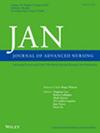Evaluating Procedure Videos to Support Clinical Nurses With Rare Procedures: Impact on Anxiety and Clinical Reasoning in a Pre-Post Study.
IF 3.4
3区 医学
Q1 NURSING
引用次数: 0
Abstract
AIMS To evaluate clinical nurses' perceptions and acceptability of procedure videos developed to support them during rare clinical procedures. In addition, a secondary aim was to investigate whether these videos reduce anxiety and enhance clinical reasoning. DESIGN A descriptive multi-methods study within a pre-post-implementation evaluation design. METHODS Seven locally developed procedure videos (non-invasive ventilation (n = 2), temporary cardiac pacing (n = 3) and pericardiocentesis (n = 2)) were evaluated using questionnaires before and after a 6-month implementation period at a local health district in Australia. Participants self-rated their clinical reasoning skills in response to video procedures, mapped against the Clinical Reasoning cycle stages. The Spielberger State-Trait Anxiety Inventory (STAI) assessed anxiety towards rare procedures. Data from open-ended questions were analysed using inductive content analysis. RESULTS A total of 247 participants completed the pre-implementation questionnaire, and 133 completed the post-implementation questionnaire. Before implementation, many reported feeling heightened anxiety when faced with rare or infrequent procedures, reporting levels that exceeded commonly accepted clinical thresholds for concern. Content analysis revealed persistent concerns among participants, including the need for support during new procedures and a fear of making errors. Before implementation, participants reported searching online for videos to support undertaking new procedures. Following implementation, most participants reported that viewing the videos enhanced their learning experience and improved their clinical reasoning. Perceived anxiety towards undertaking rare procedures was not significantly different from post-implementation. CONCLUSION This study highlights the need for timely support during infrequent clinical procedures, as participants reported anxiety about them. It also demonstrates that procedure videos are valued tools for nurses before rare clinical procedures. IMPLICATIONS FOR THE PROFESSION AND/OR PATIENT CARE Rare procedures are linked to nurse anxiety and mixed emotions, some of which may be eustress. Organisations can enhance clinical resources for nursing staff by providing online videos tailored to local practices and context, which many nurses find helpful for improving clinical reasoning when undertaking rare procedures. IMPACT This study highlights the anxiety nurses experience before rare procedures and the significance of incorporating multimedia resources, especially online videos, in nursing professional development for rarely performed procedures. Additionally, it informs employers about nursing staff preferences. REPORTING METHOD SQUIRE 2.0 reporting was adhered to. PATIENT OR PUBLIC CONTRIBUTION None.评估手术录像以支持临床护士进行罕见手术:对焦虑和临床推理的影响。
目的评估临床护士对罕见临床手术录像的认知和可接受性。此外,第二个目的是调查这些视频是否能减少焦虑和提高临床推理能力。设计在实施前-实施后评估设计中进行描述性多方法研究。方法采用问卷调查的方式,在澳大利亚某地方卫生区对7个当地开发的手术录像(无创通气(n = 2)、临时心脏起搏(n = 3)和心包穿刺术(n = 2)实施前后6个月进行评估。参与者自我评价他们的临床推理技能,以回应视频程序,映射到临床推理周期阶段。斯皮尔伯格状态-特质焦虑量表(STAI)评估对罕见手术的焦虑。采用归纳内容分析法对开放性问题的数据进行分析。结果共247名受试者完成实施前问卷,133名受试者完成实施后问卷。在实施之前,许多人报告说,当面对罕见或不常见的手术时,他们感到高度焦虑,报告的水平超过了普遍接受的临床关注阈值。内容分析揭示了参与者持续存在的担忧,包括在新程序中需要支持和害怕犯错。在实施之前,参与者报告在网上搜索视频以支持实施新程序。实施后,大多数参与者报告说,观看视频增强了他们的学习经验,提高了他们的临床推理能力。对进行罕见手术的焦虑感与手术后没有显著差异。结论:本研究强调了在不频繁的临床过程中需要及时的支持,因为参与者报告了对他们的焦虑。它也表明,程序视频是宝贵的工具,护士在罕见的临床程序。对职业和/或病人护理程序的启示与护士焦虑和复杂的情绪有关,其中一些可能是压力。组织可以通过提供适合当地实践和背景的在线视频来增强护理人员的临床资源,许多护士发现这有助于在进行罕见手术时提高临床推理能力。影响本研究强调了护士在罕见手术前的焦虑体验,以及在罕见手术护理专业发展中整合多媒体资源,特别是网络视频的重要性。此外,它还告知雇主护理人员的偏好。报告方法采用squire 2.0报告。病人或公众捐款无。
本文章由计算机程序翻译,如有差异,请以英文原文为准。
求助全文
约1分钟内获得全文
求助全文
来源期刊
CiteScore
6.40
自引率
7.90%
发文量
369
审稿时长
3 months
期刊介绍:
The Journal of Advanced Nursing (JAN) contributes to the advancement of evidence-based nursing, midwifery and healthcare by disseminating high quality research and scholarship of contemporary relevance and with potential to advance knowledge for practice, education, management or policy.
All JAN papers are required to have a sound scientific, evidential, theoretical or philosophical base and to be critical, questioning and scholarly in approach. As an international journal, JAN promotes diversity of research and scholarship in terms of culture, paradigm and healthcare context. For JAN’s worldwide readership, authors are expected to make clear the wider international relevance of their work and to demonstrate sensitivity to cultural considerations and differences.

 求助内容:
求助内容: 应助结果提醒方式:
应助结果提醒方式:


